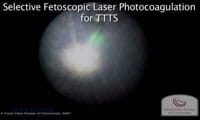Selective Fetoscopic Laser Photocoagulation for Twin-Twin Transfusion Syndrome
At 43 years of age and carrying triplets, Sherry Connell had a high-risk pregnancy that was complicated even further when her physicians diagnosed twin-twin transfusion syndrome (TTTS) in two of her three babies at 18 weeks’ gestation.
TTTS is one of the most challenging clinical problems concerning multiple gestations. It is a phenomenon almost exclusive to monochorionic twin pregnancies with mortality rates approaching 80 percent to 100 percent if left untreated.
Sherry Connell’s physicians advised her to set up an evaluation with the Cincinnati Children's Fetal Care Center. At 20 weeks’ gestation, Sherry had a full day of diagnostic tests including fetal MRI, fetal level II ultrasound and fetal echocardiogram. She and her husband met with a team from the Fetal Care Center that included director Timothy Crombleholme, MD, FACS, FAAP, and a Maternal Fetal Medicine specialist to discuss the results of the tests, the progression of the condition and their treatment options.
Tests revealed Stage IIIC TTTS. One of the affected twins – the “donor” twin – was undersized, and access to maternal nutrition was restricted. The other twin – the “recipient” twin – was receiving nearly double the blood volume to pump due to the vascular connections. These vascular connections were causing the recipient twin to develop heart failure. Crombleholme informed the Connells that the twins were within days of dying in utero. Their recommendation for selective fetoscopic laser photocoagulation as a course of treatment was accepted by the Connells.
The surgeon and MFM performed a selective fetoscopic laser photocoagulation (SFLP) procedure that selects only those vessels for coagulation that appear to connect the circulations of the twins. The procedure was performed the day after the evaluation. Following the procedure, an echocardiogram revealed modest improvement in the heart failure of the recipient twin. In addition, Crombleholme informed Sherry that the flow of nutrition to the donor twin had improved.
Despite the overwhelming odds of being 43, carrying triplets and receiving fetoscopic treatment for TTTS, Sherry carried the triplets to 30 weeks and one day. Carrying them longer than expected helped enable the heart damage to improve significantly. The triplets spent the next 10 weeks in the newborn intensive care unit at Sherry’s local hospital in Columbus, OH. Now over 20 months old, the twins are being checked monthly and are meeting or exceeding their developmental milestones.
Contact the Fetal Care Center
If you would like to request an appointment or get more information about the Cincinnati Children's Fetal Care Center, call us at 1-888-338-2559 (1-888-FETAL59).




